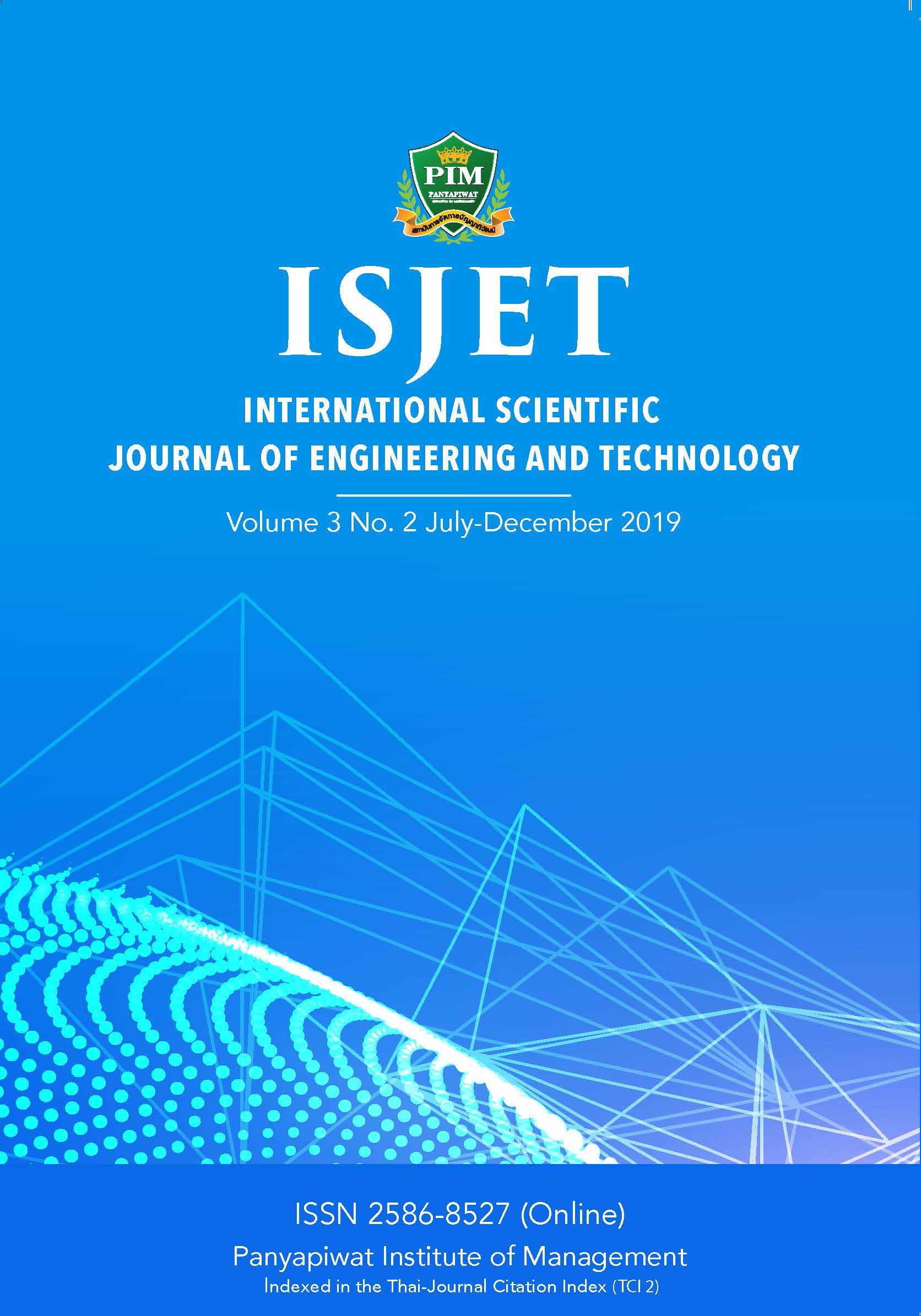Development of an RFID System for Fixed Asset Monitoring in a University: A Case Study
Main Article Content
Abstract
This paper aims to develop a radio frequency identification (RFID) system for fixed asset monitoring and control in a University. It includes selection of hardware, design and development of software, identification of suitable position and how to attach RFID tags to the fixed assets to obtain 100% readability, conducting experiments to determine the accuracy and time required to read the RFID tags, and performing economic analysis of the RFID system. A case study with real implementation in three selected rooms of Sirindhorn International Institute of Technology, Thammasat University, was performed. Experimental results show that the developed RFID system can achieve 100% accuracy, significantly reduce total time for fixed asset check when compared with the manual system, and economically justified when the number of fixed asset items is relatively high.
Article Details
เนื้อหาข้อมูล
References
Available: https://doi.org/10.1108/F-05-2013-0041
[2] J. S. L. Ting and A. H. C. Tsang. (2012, Jan.). Design of an RFID-based Inventory Control and Management System: A Case Study. The West Indian Journal of Engineering. [Online]. 34(1-2), pp. 70-79. Available: https://sta.uwi.edu/eng/wije/vol3401-02_jan2012/documents/Abstract-Inventory-ControlandManagementSystem.pdf
[3] X. Qing, Z. N. Chen, and A. Cai, “Multi-loop antenna for high frequency RFID smart shelf application”, 2007 IEEE Antennas and Propagation Society International Symposium, 2007, pp. 5467-5470.
[4] N. Adhiarna and J. Rho, “Standardization and Global Adoption of Radio Frequency Identification (RFID): Strategic Issues for Developing Countries,” 2009 Fourth International Conference on Computer Sciences and Convergence Information Technology, 2009, pp. 1461-1468.
[5] Y. Bai, F. Wang, P. Liu, C. Zaniolo, and S. Liue, “RFID Data Processing with a Data Stream Query Language,” in Proc. 2007 IEEE 23rd International Conference on Data Engineering, 2007, pp. 1184-1193.
[6] S. A. Joseph and N. J. Joby, “Analyzing RFID tags in a distributed environment,” in Procedia Technology-24-ICETEST, 2015, pp. 1483-1490.
[7] X. Jia, Q. Feng, T. Fan, and Q. Lei, “RFID technology and its applications in Internet of Things (IoT),” in proc. 2012 2nd International Conference on Consumer Electronics, Communications and Networks (CECNet), 2012, pp. 1282-1285.
[8] A. Suriyasomboon and V. Chavananikul, “Electronic identification of pigs in Thailand,” in proc. IAALD AFTA WCCA, 2008, pp. 1059-1062.
[9] K. V. Raju, D. Sachan, and S. Biswas. (2013, Feb.). Application of RFID based inventory management system in power project sites. International Journal of Innovative Research and Development. [Online]. 2(2), pp. 313-327. Available: https://www.ijird.com/index.php/ijird/article/download/35002/28199
[10] M. Dhanalakshmi and U. Mamatha, “RFID based management system”, in Proc. of ASCNT, 2009, pp. 227-234.
[11] H. Vogt, “Efficient Object Identification with Passive RFID Tags,” in Mattern F., Naghshineh M. (eds) Pervasive Computing, Pervasive 2002. Lecture Notes in Computer Science, vol. 2414, 2002, pp. 98-113.
[12] I. Satyanarayana, N. B. C. Sidhu, and A. Naresh. (2015, Mar.). Evaluation of fixed assets management. International Journal of scientific research and management. [Online].3(3). pp. 2500-2504. Available: https://www.ijsrm.in/index.php/ijsrm/article/download/503/445/
[13] C. Sun, “Application of RFID technology for logistics on Internet of Things,” AASRI Procedia, vol. 1, pp. 106-111, 2012.
[14] K. Micheal and L. McCathie, “The pros and cons of RFID in supply chain management,” in Proc. 4th Annual International Conference on Mobile Business, ICMB 2005, pp. 623-629.
[15] F. Tsai and C. Huang, “Cost-benefit analysis of implementing RFID system in port of Kaohsiung,” Procedia-Social and Behavioral Sciences, vol. 57, pp. 40-46, 2012.
[16] A. K. Masum, F. Bhuiyan, and M. A. K. Azad. (2013). Impact of Radio Frequency Identification (RFID) technology on supply chain efficiency: An extensive study. Global Journals. [Online]. 13(4), pp. 9-15. Available: https://globaljournals.org/GJRE_Volume13/3-Impact-of-Radio-Frequency-Identification.pdf
[17] A. Dukyil, A. Mohammed, and M. Darwish. (2018, Jan.). Design and optimization of an RFID-enabled passport tracking system. Journal of Computational Design and Engineering, 5(1), pp. 94-103. Available: https://www.sciencedirect.com/science/article/pii/S2288430017300301?via%3Dihub
[18] J. S. Choi, H. Lee, D. W. Engels, and R. Elmasri. (2012, Mar.). Passive UHF RFID-Based Localization Using Detection of Tag Interference on Smart Shelf. IEEE Transactions on Systems, Man, and Cybernetics, Part C (Applications and Reviews). [Online]. 42(2), pp. 268-275. Availible: https://ieeexplore.ieee.org/document/5751704
[19] A. Motamedi, M. M. Soltani, and A. Hammad. (2013, Oct.). Localization of RFID-equipped assets during the operation phase of facilities. Advanced Engineering Informatics. [Online]. 27(4), pp. 566-579. Available: https://dl.acm.org/citation.cfm?id=2561199
[20] J. Royo, P. Lamban, J. Valencia, M. Olivera, and M. Monreal,“Study to determinate the feasibility of RFID to facilitate traceability in a logistic operator,” Procedia Engineering, vol. 63, pp. 829-834, 2013.
[21] F. Costa, M. S. Carvalho, J.M. Fernandes, A.C. Alves, and P. Silva, “Improving visibility using RFID – the case of a company in the automotive sector,” Procedia Manufacturing, vol.13, pp. 1261-1268, 2017.


